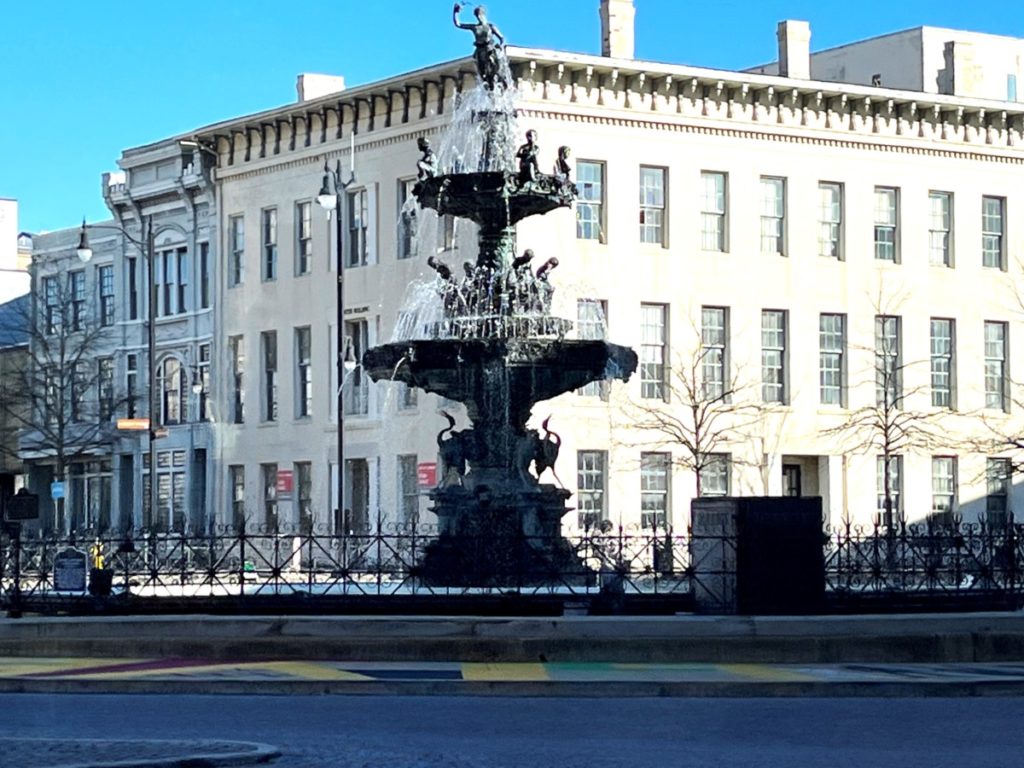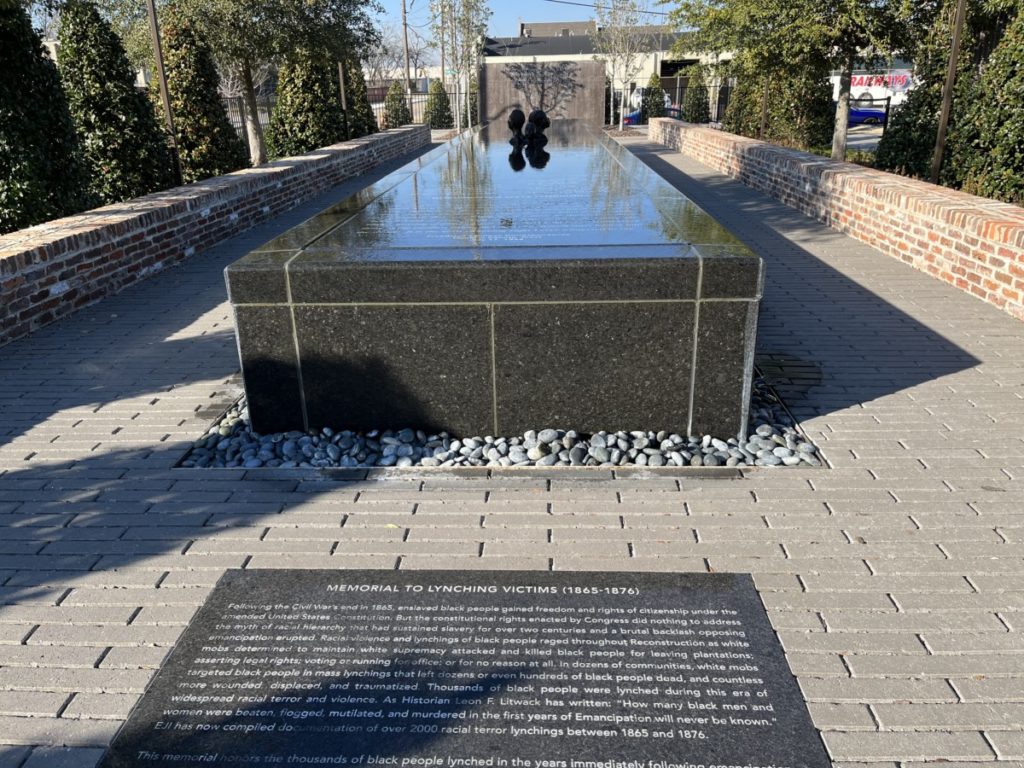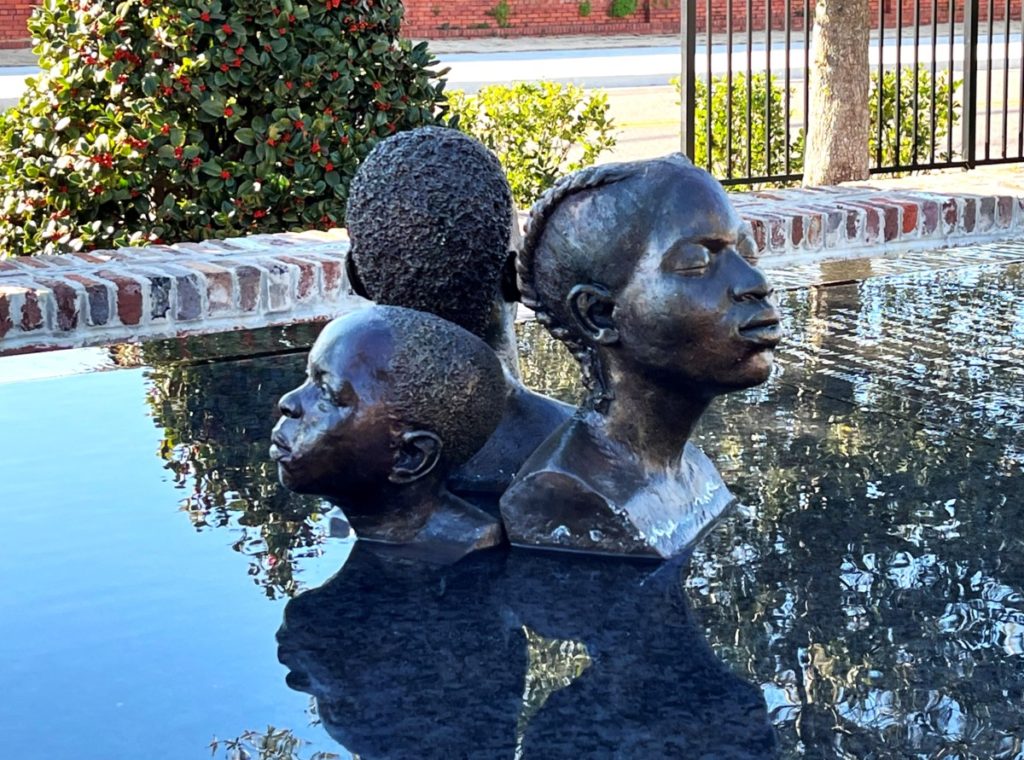For a couple of years, I heard about a new museum in Montgomery dealing with slavery. I finally made the drive to The Legacy Museum – From Enslavement to Mass Incarceration recently. Opened in 2018 by the Equal Justice Initiative (EJI), the museum’s $5 online ticket price also included admission to the National Memorial for Peace and Justice about 1.5-miles away.
This is a hard post to write. For two reasons. First the subject matter is heavy – slavery and lynching. And second, the museum doesn’t allow photography inside so I have to try to paint word pictures for you. The Legacy Museum is well done and brings forth subjects that have been swept under the rug for far too long.
The overall message of the museum is that slavery didn’t end; it evolved.
- Kidnapped: 12 million people from Africa are kidnapped as part of the Transatlantic slave trade.
- Terrorized: 9 million black people terrorized by the threat of lynching violence.
- Segregation: 10 million African American citizens segregated.
- Incarcerated: 8 million Americans under criminal control.
Slavery
The narrative for slavery in the United States begins in 1619 when 20 Africans arrived in Jamestown. A century before, Portugal and other European nations set their sites on Africa for purchasing slaves. As the need for more slaves increased, so did the kidnappings. During the Trans-Atlantic slave trade, approximately 10-12 million people were forcibly taken from Africa to the New World. Think about this – that number is larger than today’s population of Los Angeles County.
Inhumane conditions caused the death of 2 million Africans during the journey overseas. The next gallery featured a dark room with a beach and moving ocean waves on both sides. Walking along, over 200 sculptures of heads peek out over the ocean waves depicting the victims who didn’t make it.
As visitors wonder why slavery continued, the following room depicts the economic benefits of slavery in the New World. It wasn’t just the South with free labor on sugar plantations in Louisiana, rice plantations in Charleston, and tobacco plantations in the Chesapeake region, but Boston and New York as well.

When the Federal Government banned the Trans-Atlantic slave trade in 1808, another problem developed – the domestic slave trade. From 1808-1865, 1 million slaves moved from the Upper South to the Lower South, permanently separating over 50% of black families. Owners sold kids out of their mother’s hands, husbands from wives, and siblings from the comfort of each other.
Transported slaves came to the Lower South primarily via ships and trains. From there, they were held in slave pens until purchased. Jail bars with separate cells lined the next room. Inside each cell, a hologram tells their story. A man sings spirituals, a mother loses her three children to another plantation, and a child cries out, “Mama” as she is taken away to another owner.
Southerners claimed that slaveholders were “kind and generous” while the enslaved were “fortunate.” That certainly wasn’t the case when looking at a 15-foot tall x 6-foot wide photo of a slave’s back with scars from repeated whippings. Many states allowed beating slaves as evidenced by the state of Maryland in 1729. The state deemed it appropriate to punish slaves for learning to read by whipping with a cowhide.
However, slaves were helpless in the matter. In 1855, a slave named Celia killed her master Robert Newson in self-defense. For five years, he repeatedly raped her and she bore at least one of his children. She had enough and killed him when he came into her bedroom yet again. The justice system convicted and sentenced her to death in a matter of days.
Slavery is the next thing to hell.
Harriett Tubman
Lynching
Once the Civil War ended, things were still difficult. Many Black people thought they’d get 40 acres of land and a mule. It never happened. Even the language of the 13th Amendment was vague. It abolished slavery except “as punishment for a crime.” This led to a prevalence of Black Codes. If a Black person couldn’t show they had a job, police arrested him for vagrancy.
Slavery unfolded into the convict leasing system, sharecropping, and tenant farming. In 1898, convict leasing provided 73% of Alabama’s state revenue.
Although the 14th Amendment gave citizenship to Blacks in 1868, voting rights were still very hard to come by. The Opelousas Massacre came about in 1868 as white supremacists beat Emerson Bentley, a white man who taught Black students in school. Rumors of Bentley’s death (he actually fled to New Orleans) caused Blacks to retaliate. In the end, somewhere between 150-300 Black people were killed.

The US government seemed to do little to enforce the fair treatment of Blacks. A chart shows court cases during Reconstruction. For example, in 1903 Giles v. Harris, the US Supreme refuses to intervene in the Alabama state constitution prohibiting Blacks from voting.
In 1868, John Willis Menard from Louisiana became the first Black to win a seat to Congress. His opponent challenged the election and Congress denied his seat. The same thing happened in 1872, when Louisiana’s Black Governor (the only Black governor during Reconstruction), PBS Pinchback won a seat in the US Senate. After a year of controversy and opposition, the Senate also refused to seat him.
To reinforce white supremacy, lynchings began. And they weren’t secret either. One wall shows headlines from local newspapers. They’re sickening.
- “Lynched Because He Didn’t Say Mister.”
- “Louisiana Mob Chases Complaintant Against White Man.”
- “Citizens of Corsicana Savagely Tortured John Henderson.”
- “Negros Lynched for Defending Woman.”
- “Mob of 5,000 Hang 3 Negroes from Telephone Pole in Duluth.”
The next wall features eyewitness accounts and the last words of many victims. In many cases, they kept proclaiming their innocence up until the point of death. A large wall features jars of soil with a person’s name, date, and place of their lynching. In the middle of the room, touchscreens show videos and a map of the US. where visitors can touch a section to see victims from a particular county or parish.
In 1912, Police arrested a Black man, Thomas Miles, for allegedly writing notes to a white woman. The Shreveport resident said a white man asked him to pass it along to a white woman for him. The white man had even signed the notes. The police released him from jail, but his innocence didn’t matter to the mob that lynched him on his way home. Later in the museum, descendants of the family discuss the effect of the lynching in a video you can see here.
Private James Neely, serving in the all-Black Regiment in the Spanish-American War, wanted to purchase a drink at a drugstore in Hampton, GA. When refused service, he briefly argued with the owner. As he turned to leave, several townspeople came and lynched Neely.
A picture of Laura Nelson and her son hanging from a bridge outside Okemah, OK reveals the true nature of some of the citizens. Hundreds came to see the bodies and many pose in the picture with them.
Tired of all of this, many Black families moved out of the southern states. From 1916 to 1970, approximately 6 million people participated in the Great Migration. But for those who stayed in the south, unequal “separate but equal” conditions prevailed.
Segregation
In this gallery, one wall posts signs common during segregation. One advertisement talks about the beauty of Mena, Arkansas and highlights great schools and other amenities. In the other column it says the town has “no mosquitos, no malaria, no blizzards, and no Negroes.” A sign from 1951 reads “No Negroes or Apes.” Others say “Elk Wallow Picnic Grounds – for White only.” “No Blacks. No Jews. No Dogs.” “We employ white help and cater to white people.” “Non-whites will not be served this side of the line.”

Another room lets visitors take a poll test to see how they would do. The questions are ridiculous. How many jellybeans are in this jar? Or. how many bubbles are in a bar of soap? How many seeds are in a watermelon? How may the county seat be changed under the constitution of your state? What does a Writ of Certiorari, Writ of Error Coram Nobie, and Subpoena Duces Tecum mean? You get the picture.
After Brown vs. Board of Education, many southern states fought integration. Famous politicians weighed in on their opinion.
- Alabama Governor George Wallace – “Segration Now. Segregation Tomorrow. Segregation Forever.”
- Arkansas Governor Orval Faubus – “I will never open the public schools as integrated institutions.”
- James F. Bynes, a governor of South Carolina and an associate Justice for the Supreme Court – “This is a white man’s country and will always be a white man’s country.”
We’ve all heard of Rosa Parks, but I didn’t realize that her actions sparked the Montgomery bus boycott that lasted 13 months. A film discusses the boycott in detail but also highlights the inspiration for Rosa Parks’ action – the brutal murder of Emmett Till. After her 14-year-old son’s murder in Mississippi for allegedly whistling at a white woman, Mamie Till had the body sent back to Chicago. Shocked by what she saw, she invited Jet magazine to take pictures and opened the casket for the 100,000 mourners at the funeral.
Mass Incarceration
Police are six times as likely to arrest a Black person than a white person for the same crime. During the Nixon administration, the War on Drugs was meant to incarcerate Blacks according to Nixon’s domestic policy advisor John Ehrlichman. This exhibit recreates a prison visiting room. Visitors sit across a glass barrier and pick up the phone. The pre-recorded prisoner on the other side picks up the phone and tells their story. One woman serving a 24-year sentence was raped and impregnated by a male guard. More heartbreaking is that she is now separated from that daughter she bore.
A touch screen in another section of the gallery shows the 60 Minutes episode regarding Walter McMillan, an innocent Black man who served 6 years on death row before getting released. Another film relays the story of Anthony Ray Hinton, an innocent Black man who served 30 years on Alabama death row. He mentioned that the ballistics expert who originally said his gun was the murder weapon was blind in one eye and didn’t know how to turn the machine on. With the help of Bryan Stevenson of the Equal Justice Initiative (EJI), he was released after several years of the appeals process. Today, Hinton works with the EJI, which runs the museum.
Reflecting Room
The museum concludes with two more exhibits. In the Reflecting Room, chairs sit in the center. The walls are decked out with civil rights activists including Josephe Lowery, Mary Jackson, Ruby Dee, and Patricia Bath. Negro spirituals resound in the background and a TV screen showing police brutality plays on one wall.
Art
The last exhibit features art from prominent Black artists. Gordon Park’s photographs hang on one wall. A quilt titled “Bad Blood” by Darn Williams Boyd depicts the Tuskeegee Syphillis Experiments. I found Glenn Ligon’s lithograph series “Runaways” interesting.
Getting Around
A large parking lot and street parking (both free) is available at the Legacy Museum. While you can walk to the memorial, they offer free shuttles every 10 minutes. At the memorial, parking is available so you could drive there as well. Pannie-George’s Restaurant and a bookstore is also onsite at the Legacy Museum, but I didn’t go into either one.

The website recommends 3-5 hours to tour the museum and at least 1-1.5-hours to spend at the memorial. I stayed a little over three hours in the museum and could easily have spent more time. I toured the memorial in 20 minutes and feel I could have spent another 10-15 minutes there.
Conclusion
A YouTube Video shows founder Bryan Stevenson discussing the museum to BNC News. In the 10-minute video, you can see some of the exhibits this post mentions: slave pens with holograms at the 1.33-minute mark, newspaper ads for slaves at the 3.30-minute mark, picture of a slave’s scars from whipping at the 4.19-minute mark, the wall of soil jars at the 6.04-minute mark, and the prisoners talking through the video phones at the 6.14-minute mark.
This is a powerful museum and I highly recommend it. You can find out about hours and tickets here.
I’ll do another post soon for Part 2 – The National Memorial for Peace and Justice.
